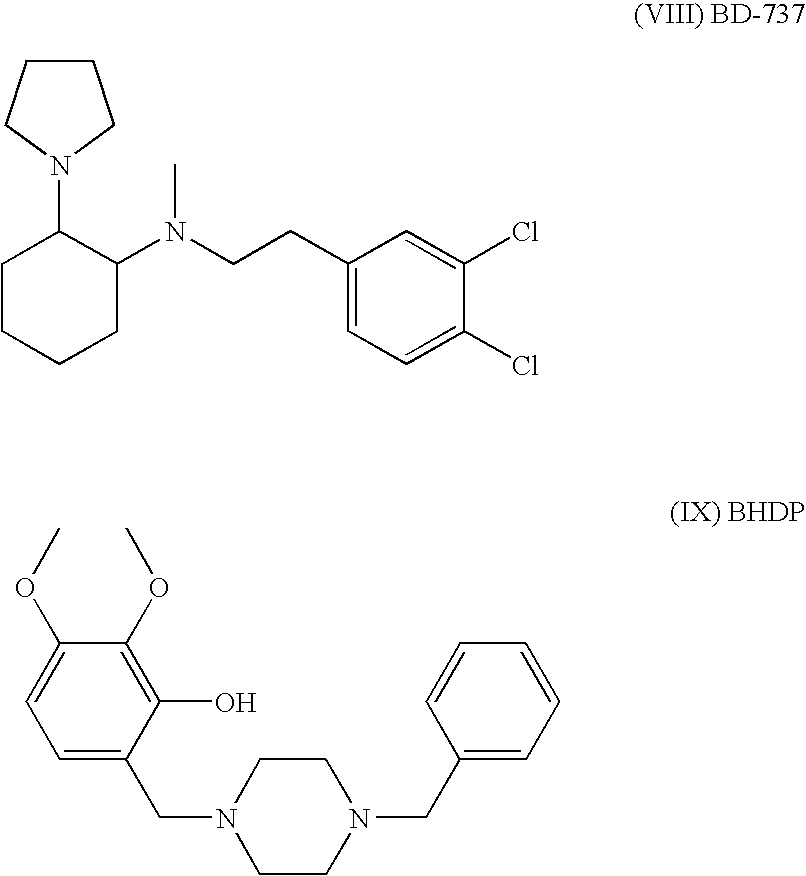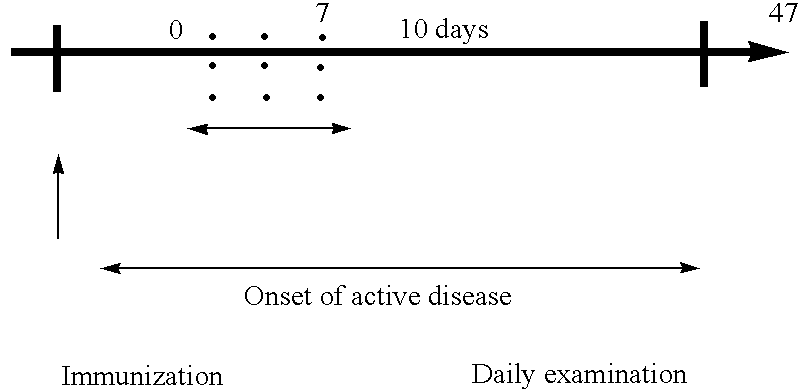Sigma ligands for neuronal regeneration and functional recovery
a neuronal regeneration and functional recovery technology, applied in the field of treatment, can solve the problems of paralysis, speech problems and dementia, side effects, little or no effect on fatigue and depression, etc., and achieve the effect of facilitating functional recovery and combating the progression and symptoms of ms
- Summary
- Abstract
- Description
- Claims
- Application Information
AI Technical Summary
Benefits of technology
Problems solved by technology
Method used
Image
Examples
example 1
Animal Models for Neuronal Regeneration (Functional Recovery)
[0108]Male 3 months old SHR (spontaneous hypertensive) rats are used for induction of stroke by MCA occlusion. This is the preferred strain since most stroke patients are hypertensive. The animals are anesthetized with Methohexital and a small craniectomy is made above the zygmotic arch to expose the middle cerebral artery, which is occluded with a 10-0 monofilament nylon thread distal to the origin of the striatal branches. The rats are not intubated and no catheters are inserted. Following MCA occlusion a large and reproducible infarct is obtained, leading to a robust sensorimotor deficit. The animals are kept on a 6 hr light / 18 h dark cycle with free access to food and water. At two days after the MCAO the rats are treated with the compound I, II, III, IV, V, VI, VII, VIII, or IX (0.03-10 mg / kg) s.c. or p.o. and a control group is given saline for 2-8 weeks. At 2, 4, 6 and 8 weeks animals are tested in the rotating pole...
example 2
Evidence of Neuronal Regeneration in Rats Treated with AGY-94806
1. Rotating Pole
[0120]Thirty five spontaneously hypertensive rats were exposed to permanent middle artery occlusion (MCAO), then divided into three treatment groups. Starting at two days after occlusion and continuing daily until 28 days after occlusion, AGY-94806 was administered s.c. in doses of 0.3 mg / kg (12 rats) or 1.0 mg / kg (12 rats). In a control group (11 rats), vehicle only was administered. At the start of treatment, and at several time points during the test, the rats were assessed for their performance in the rotating pole model. This model is described in Example 1. It requires the rats to cross a horizontally suspended rotating pole having a length of 1 m. This task measures the sensory-motor performance of the animals. The animals' behaviour was recorded using a video camera and later analyzed and scored by a trained technician. The scoring ranges from 0 to 6, with 0 being very poor performance and 6 refl...
example 3
Gene Expression Studies
[0126]The Ethics Committee for Animal Research at Lund University approved the experimental protocol. Six-month-old male SHR (spontaneous hypertensive rats), obtained from Mollegard Breeding Center, Ejby, Denmark, 2 months earlier and preoperatively housed in standard cages (550×350×200 mm, 3 to 4 rats in each cage), were anesthetized with methohexital sodium (Brietal, 37° C.) 50 mg / kg intraperitoneally. The right MCA was accessed via a small craniotomy, and the artery was ligated distal to the striatal arteries, causing a neocortical infarct. The mean surgery time was about 20 minutes and body temperature was maintained close to 37° C. Postoperatively, rats were kept in individual cages for 24 hours. The rats subjected to MCA occlusion (MCAO) were either returned to standard environment (SE), or were placed in a large, vertical, enriched-environment (EE) cage (815×610×1,280 mm), equipped with horizontal and vertical boards, chains, swings, wooden blocks, and ...
PUM
| Property | Measurement | Unit |
|---|---|---|
| time | aaaaa | aaaaa |
| concentration | aaaaa | aaaaa |
| particle size | aaaaa | aaaaa |
Abstract
Description
Claims
Application Information
 Login to View More
Login to View More - R&D
- Intellectual Property
- Life Sciences
- Materials
- Tech Scout
- Unparalleled Data Quality
- Higher Quality Content
- 60% Fewer Hallucinations
Browse by: Latest US Patents, China's latest patents, Technical Efficacy Thesaurus, Application Domain, Technology Topic, Popular Technical Reports.
© 2025 PatSnap. All rights reserved.Legal|Privacy policy|Modern Slavery Act Transparency Statement|Sitemap|About US| Contact US: help@patsnap.com



